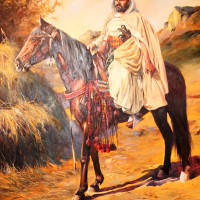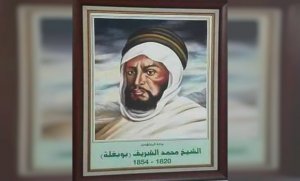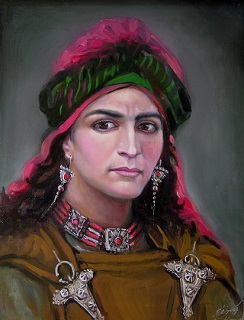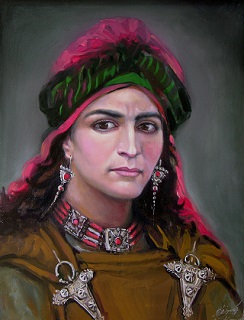The resistance in the Djurdjura region did not stop after the martyring of Cherif El-Amjed known as Bou Beghla, it continued with the leadership of Cherif El-Mokhtar Ben Kouider Titraoui; his father fought along with Cherif Bou Beghla and succeeded him after his death. However, his poor health stopped him from continuing the fight and resistance, so he assigned his son in his place and announced him a leader of the people. He was called Bou Hamara due to the donkey he rode everywhere. Aside from his father who was the mastermind and organizer of all his work, he was also helped by Boudwani, and Arezki Bournane. At first, Bou Hamara did not receive any encouragement or welcome from the elders of the region, who faced him coldly and apathy, forcing him to move to look for followers and supporters. He headed to Beni Frassen and Beni Chaib, and he called Lalla Fatma N’soumer in Ourdja village, then moved to Beni Mellikeche, which was often an invincible fort hosting rebels and resistance centers. The resistance of Bou Hmara kept spreading despite all the hardships that he encountered, especially when the French authorities increased their surveillance over the citizens to eradicate the resistance in the region. They prevented travels without permission between Beni Monklet and Beni Boussif Nevertheless, he won the support of some who were initially opposed to his movement like Cheikh Ouarab in Beni Rathen. Although his movement lasted only a short time, he led several attacks, including the 31 August 1855 attack on some French informants and their collaborators in the village of Jumaat El-Sahreej and its suburbs; there were many killed and wounded in both parties. The circumstances sentenced the end of Bou Hamara by one of his opponents who handed him to Colonel Beaupret, who ordered his beheading in front of people on 29 December 1855 to intimidate the population. His martyrdom closed another chapter of the resistance in the Djurdjura region.
The Djurdjura region faced persistent and violent confrontations against the French colonial attempts to intrude into the area, and subjugate it with military force. Several resistance figures stood out, marvelous stories emerged from this region fueled by sacrifice and pain.

Resistance of Bou Hmara
The resistance in the Djurdjura region did not stop after the martyring of Cherif El-Amjed known as Bou Beghla, it continued with the leadership of Cherif El-Mokhtar Ben Kouider Titraoui; his father fought along with Cherif Bou Beghla and succeeded him after his death. However, his poor health stopped him from continuing the fight and resistance, so he assigned his son in his place and announced him a leader of the people. He was called Bou Hamara due to the donkey he rode everywhere. Aside from his father who was the mastermind and organizer of all his work, he was also helped by Boudwani, and Arezki Bournane. At first, Bou Hamara did not receive any encouragement or welcome from the elders of the region, who faced him coldly and apathy, forcing him to move to look for followers and supporters. He headed to Beni Frassen and Beni Chaib, and he called Lalla Fatma N’soumer in Ourdja village, then moved to Beni Mellikeche, which was often an invincible fort hosting rebels and resistance centers. The resistance of Bou Hmara kept spreading despite all the hardships that he encountered, especially when the French authorities increased their surveillance over the citizens to eradicate the resistance in the region. They prevented travels without permission between Beni Monklet and Beni Boussif Nevertheless, he won the support of some who were initially opposed to his movement like Cheikh Ouarab in Beni Rathen. Although his movement lasted only a short time, he led several attacks, including the 31 August 1855 attack on some French informants and their collaborators in the village of Jumaat El-Sahreej and its suburbs; there were many killed and wounded in both parties. The circumstances sentenced the end of Bou Hamara by one of his opponents who handed him to Colonel Beaupret, who ordered his beheading in front of people on 29 December 1855 to intimidate the population. His martyrdom closed another chapter of the resistance in the Djurdjura region.
Learn moreResistance of Chérif Boubeghla
The Kbaylia region witnessed a strong resistance towards the French movements in the area. Apart from the inhabitant's strength and excitement, the harsh Natural topography contributed to determining the speed of the French incursion into the region. Perhaps the appearance of Ben Abd El-Malik Mohammed Al-Amjad had a significant impact on the area's unity against the invaders.
Learn moreResistance in the Djurdjura area
The Djurdjura region fought continuous and violent confrontations against the French colonial attempts to penetrate the region and try to subjugate it by military force. Many resistance figures emerged and the region wrote wonderful chapters of sacrifices despite its pain.
Learn moreResistance of Lalla Fatma N’Soumer
This is another episode of the confrontations against French colonization, Led by an Algerian Lioness from the great region of Djurdjura. Seeing her homeland be torn apart by French colonialism urged her to join her brother to defend their land and pride. She struck the French generals and gave them a taste of loss and misery.
Learn moreResistance of Bou Hmara
Resistance of Chérif Boubeghla
The Kbaylia region witnessed a strong resistance towards the French movements in the area. Apart from the inhabitant's strength and excitement, the harsh Natural topography contributed to determining the speed of the French incursion into the region. Perhaps the appearance of Ben Abd El-Malik Mohammed Al-Amjad had a significant impact on the area's unity against the invaders.
Resistance in the Djurdjura area
The Djurdjura region fought continuous and violent confrontations against the French colonial attempts to penetrate the region and try to subjugate it by military force. Many resistance figures emerged and the region wrote wonderful chapters of sacrifices despite its pain.
Resistance of Lalla Fatma N’Soumer
This is another episode of the confrontations against French colonization, Led by an Algerian Lioness from the great region of Djurdjura. Seeing her homeland be torn apart by French colonialism urged her to join her brother to defend their land and pride. She struck the French generals and gave them a taste of loss and misery.



